Are you wondering how to boost your business efficiency and customer satisfaction? Well creating robust order management software (OMS) is the answer.
In today’s business world, efficient order management has become significant for operational excellence and customer satisfaction. Building an OMS solution can streamline processes, reduce errors, and enhance overall productivity.
As per my research, the Order Management Software market was valued at USD 2.95 billion in 2023, and it is expected to increase at a CAGR of 5.48% between 2024 and 2030.
This data depicts a lucrative business opportunity for entrepreneurs to support a vital component of modern commerce. By investing in OMS development, businesses can leverage cutting-edge technology to adapt to market demand, stay competitive and attain scalable growth.
So, are you ready to create order management software? If yes, read this blog. It will include everything you must learn before building an OMS solution for your business.
Quick Summary: Learn how to develop order management software with this comprehensive guide. It will guide you through a simple order management software development process, must-have features, cost required, benefits, different industries, and tech stack. So, without a further second, let’s start.
Introduction of the Order Management Software
Order management software is a digital solution that streamlines and automates business order handling. The system manages orders from start to finish, assuring efficiency. Order input, inventory management, order processing, and CRM are typical OMS functions.
The software aims to improve order processing efficiency and accuracy. Offering real-time inventory insights helps businesses manage goods and avoid overstocking and stockout.
Furthermore, OMS connects physical and online sales channels to consolidate orders into one system, enabling the division to enhance effective communication, reduce errors, and boost customer satisfaction.
Market Analysis of Order Management Software
- According to a reasonable estimate, the size of the global Multichannel Order Management Market in terms of revenue was $2.7 billion in 2022.
- This market is expected to increase at a quicker Compound Annual Growth Rate (CAGR) of 9.4%, reaching over $4.2 billion by the end of 2027.
- The revenue that is anticipated to be generated by the worldwide order management software market in 2022 is estimated to range between 2.7 billion and 2.95 billion US dollars.
- According to projections, the market is expected to continue expanding over the next several years, with a compound annual growth rate (CAGR) that falls somewhere between 5.48 and 11.6%.
Order Management System in Different Industries
What if you run a business and you have hundreds of orders across different channels (phone, store, and website), and for different products with fluctuating stock levels. It sounds good but can create challenges for you to manage all the orders at once.
That’s where the order management software comes in. so, if you want to know how order management software are useful in different industries, look here:
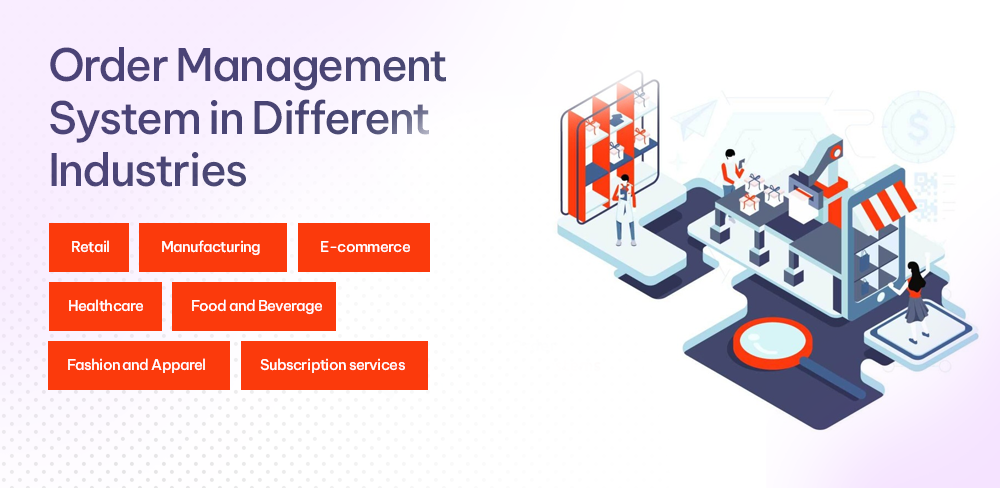
- Retail
- Manufacturing
- E-commerce
- Healthcare
- Food and Beverage
- Fashion and Apparel
- Subscription services
1. Retail
OMS manages orders from physical shops, online stores, and marketplaces. The retail management software solution helps businesses track inventory across different locations and ensure a smooth pick-and-pack process so that orders can quickly be fulfilled.
2. Manufacturing
In the industry, businesses gain better visibility in production and order fulfillment. With manufacturing software development, businesses can trace raw materials, manage production schedules, and ensure on-time deliveries that help ensure quick production and keep customers satisfied.
3. E-commerce
OMS in e-commerce businesses streamlines online order processing. As per the ecommerce software development company, the system is integrated with shopping carts. It automates order confirmation emails and provides customers with real-time tracking information.
4. Healthcare
OMS ensures accurate order fulfillment for significant medical supplies. The healthcare software development services help businesses comply with strict regulations, manage expiration dates, and ensure safe delivery.
5. Food and Beverage
In the food and beverage industry, OMS handles all the perishable items and particular delivery requirements. So, ensure a successful food ordering app development to manage temperature-controlled storage, track item’s expiration dates, and schedule deliveries for optimal freshness.
6. Fashion and Apparel
Software for order management deals with frequent style changes, different sizes, and seasonal trends. The system assists businesses with tracking inventory by color, size, and style, preventing stockouts and overstocking.
7. Subscription Services
OMS automates recurring orders and manages customer preferences. The software helps create subscription plans, automates product renewals, and makes personalized deliveries based on customers’ requirements.
Top 5 Order Management Software
If you are curious to know about to 5 order management system software, look here:
- Shopify
- Fishbowl
- Orderhive
- Mckesson
- Ordermaek
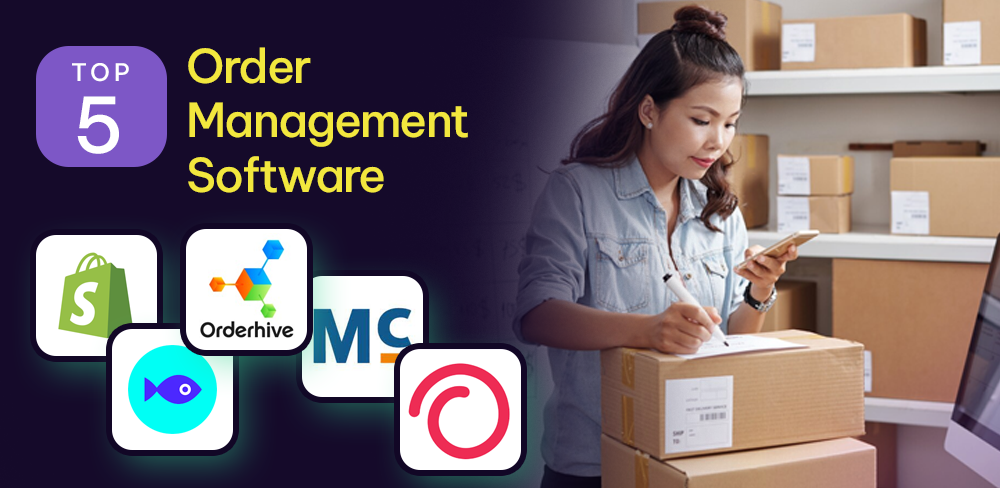
1. Shopify
Shopify order management software is an all-in-one e-commerce platform with various order management functionalities and features for creating online stores, managing products, and processing payments.
2. Fishbowl
This MRP (material requirements planning) system is designed for manufacturing. The software excels at product scheduling, tightly controls inventory, and efficiently manages work orders.
3. Orderhive
It’s an all-on-order management system that is built for e-commerce businesses. The platform tackles inventory management across different sales channels, automates fulfillment procedures, and provides valuable insights to help optimize business operations.
4. Mckesson
As a leader in healthcare supply chain management, the platform offers order management solutions tailored to hospitals and other medical providers. It streamlines the ordering process, which ensures businesses have significant supplies readily available.
5. Ordermaek
It’s a B2B order management software that acts as a bridge between restaurants and their suppliers. The software automates the ordering processing, eliminates manual errors, and improves communication between parties.
Benefits of Developing the Order Management Software
Order management software has the potential to revolutionize businesses by streaming processes, improving customer satisfaction, and boosting efficiency. If you are curious to know how investment in order management software can benefit your business, consider the following compelling reasons.
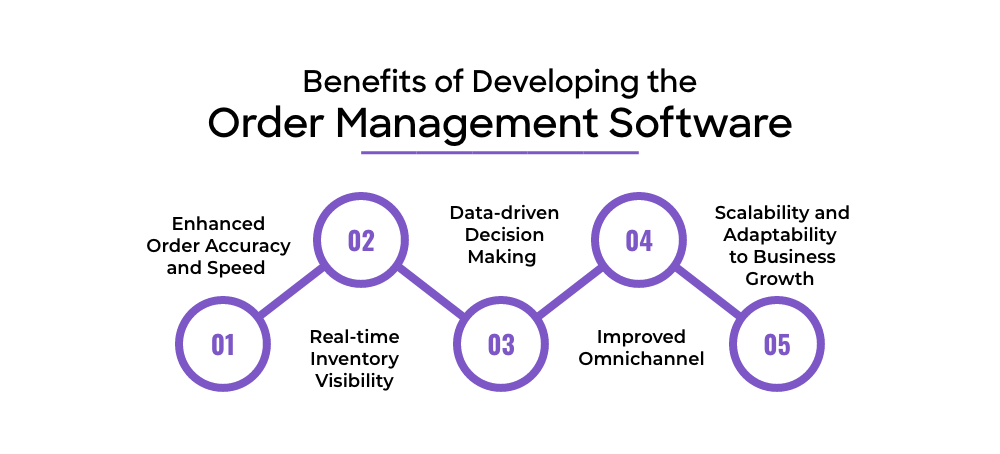
- Enhanced Order Accuracy and Speed
- Real-time Inventory Visibility
- Data-driven Decision Making
- Improved Omnichannel
- Scalability and Adaptability to Business Growth
1. Enhanced Order Accuracy and Speed
The order management software automates order processing tasks like capturing customer information, verifying the availability of specific products, and generating pick lists. Hence, it reduces the possibility of human error and processes the orders faster, which leads to on-time fulfillment.
2. Real-time Inventory Visibility
Order management software provides a centralized view of inventory at the workplace across different sales channels, including physical locations, online stores, and the marketplace. Hence, it reduces the risk of overselling, which is a common issue with manual inventory management.
3. Data-driven Decision Making
With OMS, businesses can collect valuable data on orders, customer behavior, and inventory levels. This data provides a wealth of insights entrepreneurs can leverage to make informed decisions by reading about different aspects of their businesses. Businesses can make data-driven decisions during growth and profitability by leveraging the data effectively.
4. Improved Omnichannel
Whether customers shop online, in-store, or through a marketplace, they expect a seamless buying experience. Here, order management software allows businesses to manage orders from all these channels in one place. It creates a unified customer journey where customers can initiate buying online and pick it up in-store or vice versa with all order details.
5. Scalability and Adaptability to Business Growth
As you know, businesses are dynamic entities that evolve constantly. Hence, order management software offers scalability and adaptability to keep pace with business growth. The OMS CAN be easily integrated with the existing system and accurately increase order volumes, expanding product lines and new sales channels.
As a mobile app developer, I have also worked for order management software development that streamlines the process of managing orders for business. The platform allows businesses to easily track orders, manage inventory, and generate reports for analysis. With significant features such as real-time order tracking and automated order processing, OMS helps businesses enhance customer satisfaction and improve efficiency.
It also integrates with other software systems to ensure seamless communication and data flow. Building an order management system has been a rewarding experience, as it has assisted businesses in optimizing their operations while enhancing overall productivity: Mohit Nag (Project Manager)
So, if you want to create order management software, be ready to learn the most simple process. I will provide an easy step-by-step guide in the blog.
Key Steps to Create Order Management Software
Now, let’s come to the main section of the blog, How to Build order management software. Do you know how to bring your idea to life? Well, developing the best work order management software involves different critical stages. If you follow those steps, no doubt you are about to attain your business goals. So, let’s understand the order management software development process with the following steps:
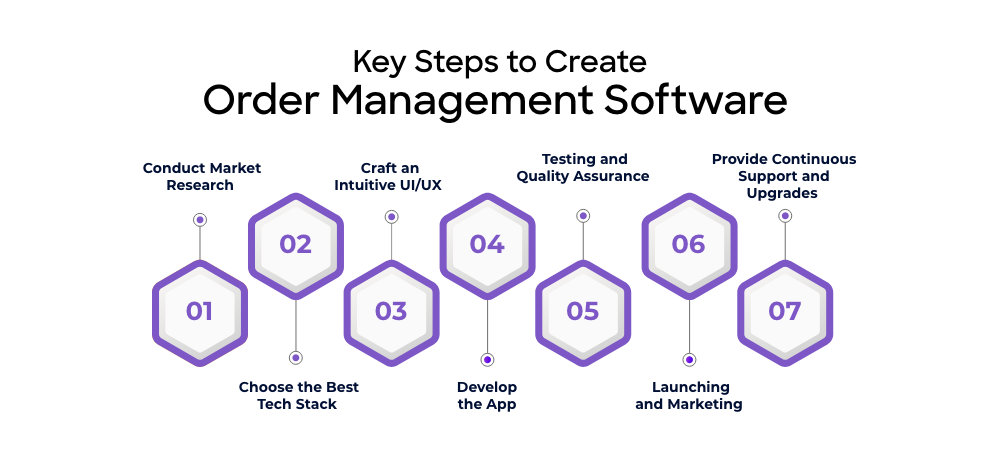
- Conduct Market Research
- Choose the Best Tech Stack
- Craft an Intuitive UI/UX
- Develop the App
- Testing and Quality Assurance
- Launching and Marketing
- Provide Continuous Support and Upgrades
1. Conduct Market Research
Developing order management software involves a meticulous journey, starting with understanding the market. A deep understanding of the target audience, wholesalers, retailers, or manufacturers will help you identify their paint points. Also, study the existing players to learn their strategies and how your app can stand out in the market.
2. Choose the Best Tech Stack
Now, with a clear vision, you need to choose the primal tech stack foundational technologies that power your management software. However, when selecting the tech stack for your app, consider factors like security, scalability, and compatibility with existing infrastructure. If you are confused about choosing the right tech stack, get assistance from a cloud software development company with detailed knowledge about programming languages, frameworks, and databases.
3. Craft an Intuitive UI/UX
Now, the user experience and user interface are necessary for a successful app. Here, you need to focus on crafting a user-friendly and intuitive interface. Ensure the development of a digital ecosystem where users can navigate seamlessly and find the information they want efficiently. However, this requires careful consideration of user workflows, visual design principles, and information architecture.
4. Develop the App
Here, the supply chain management software development company brings your vision of app development to life, coding the software’s core functions. This includes inventory management, order capture, fulfillment automation, and integration capabilities with other business systems like CRM or accounting software.
Furthermore, when creating a sales or purchase order management software, ensuring inserting all the significant and unique features, increases the possibility of software success.
5. Testing and Quality Assurance
After developing the core functionalities, it’s time to test your purchase or sales order management software to ensure it’s error-free and ready to launch. Careful testing across different scenarios identifies and resolves bugs before deployment.
User acceptance testing with potential users provides invaluable feedback for further improvements. This iterative procedure ensures a robust and polished on demand app development solution
6. Launching and Marketing
Now your software is ready, it’s time to launch it. Deploying your OMS involves making it available to users, often straying with a soft launch of release to a small group before a full-scale deployment. Furthermore, you need to craft a marketing strategy to reach the targeted audience.
You can use social media content marketing and email campaigns to create buzz for this. It helps to highlight the unique benefits of your OMS and offer trials to attract users.
7. Provide Continuous Support and Upgrades
Even after a successful launch, you need to maintain and upgrade your software, which requires ongoing support and updates. You are responsible for providing excellent customer service. This helps to address user issues and collect feedback for further improvements.
Ensure regular updates to fix bugs, enhance security, and add new features. This allows businesses to stay responsive to their users’ changing needs, keeping them happy and loyal.
Must-have Features of an Order Management Software
An efficient order management system is the backbone of smooth business operations. So, do you know how you can make your OMS efficient? Well, here is a list of top key features that you must consider for your fleet management software development, providing a seamless experience:
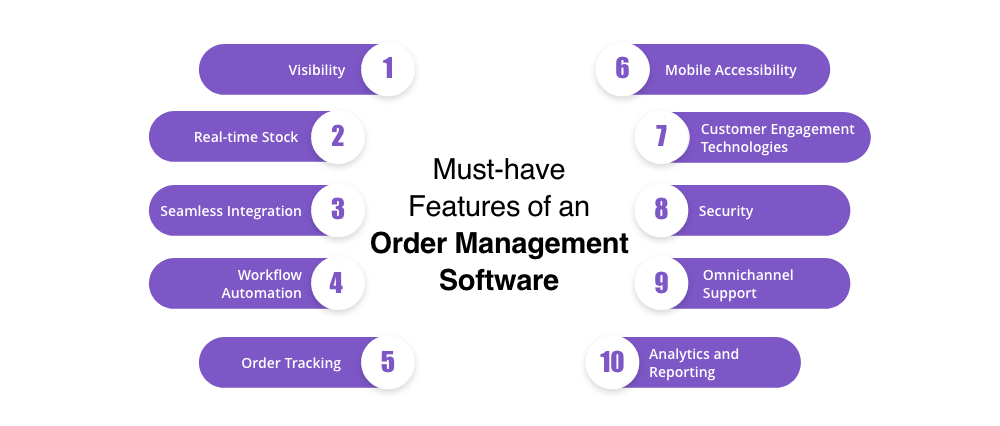
| Features | Description |
| Visibility | Oms must give the business the entire order management process visibility, allowing it to track orders, determine their inventory level, and analyze the performance metrics. |
| Real-time Stock | Create order management software that allows businesses to remain at the forefront of managing their stock levels and remove inventory level uncertainty. |
| Seamless Integration | Ensure that your system integrates with your existing CRM, warehouse, and account management software for a centralized data flow. |
| Workflow Automation | The inventory and order management software automate repetitive tasks like order confirmation, shipping notification, and two-stock alerts. |
| Order Tracking | Create order management software that tracks shipments in transit with significant information on location and accurate delivery times. |
| Mobile Accessibility | Your work order management software should manage orders and access significant information on the go with a mobile-friendly interface. |
| Customer Engagement Technologies | Your OMS must consist of personalized marketing and multi-channel support channels for effective customer engagement and retention. |
| Security | Ensure your change order management software
meets industry standards and security protocols to safeguard customer data. |
| Omnichannel Support | Create order management software that offers a consistent and personalized experience across all sales channels, including in-store and mobile. |
| Analytics and Reporting | For informed decision-making, generate detailed reports on customer behavior, order fulfillment time, and sales trends. |
Cost Analysis to Create Order Management Software
Do you know how much you need to invest in developing the best order management software? Well, determining the cost to develop a mobile app or software is more complex than it looks. Various factors, such as the app’s design, type, features, and development platform, greatly influence the cost of creating multichannel order management software.
Furthermore, if your order management software has some special or unique requirements, it will increase the app’s complexity. As a result, there will be a major fluctuation in the cost of order management software as mentioned in the table below:
| Order Management Software Development | Estimated Cost | Time Frame |
| Simple Order Management Software Development | $8000 – $13000 | 3 to 6 Months |
|
Medium-Complex Order Management Software Development |
$13000 – $21000 | 6 to 9 Months |
| High-Complex Order Management Software Development | $25000+ | 10+ Months |
Key Order Management KPIs & Metrics To Track
Order management is the backbone of a smooth customer experience that encompasses everything from the moment customers clicks “purchase” to when they get their orders. By tracking key performance indicators (KPIs) and metrics, businesses can identify the lacking areas of further improvements and ensure users’ orders are running efficiently.
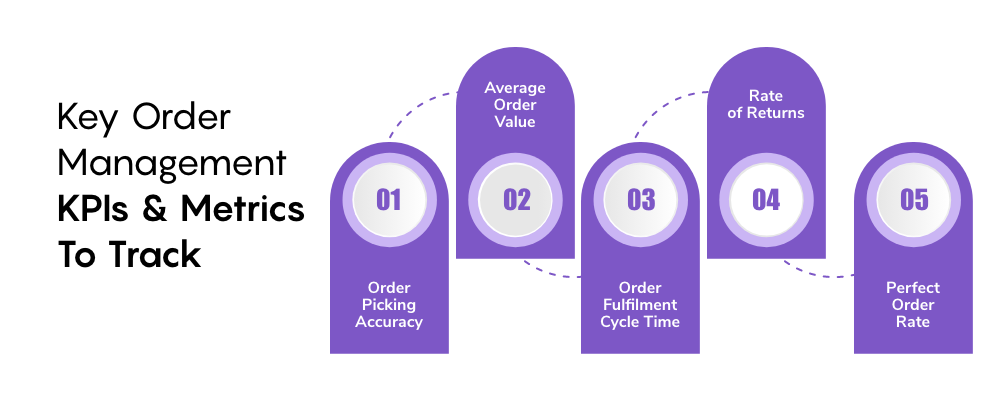
Here is a list of 5 critical KPIs to keep an eye on:
- Order Picking Accuracy
- Average Order Value
- Order Fulfillment Cycle Time
- Rate of Returns
- Perfect Order Rate
1. Order Picking Accuracy
The percentage of properly fulfilled orders with high accuracy means fewer returns, lower return processing expenses, and satisfied customers who receive what they want. Here, quality inspection during picking and fulfillment staff training can help maintain accuracy. Hence, a warehouse management software can enhance order picking accuracy by streamlining the process.
2. Average Order Value
This KPI shows the average order box. Duals win with growing average order value. Customers may be ordering several things in just one order, which indicates a wider product interest. It might also mean they are looking for more expansive things that could indicate brand trust or a trend toward specific luxury products.
3. Order Fulfillment Cycle Time
In today’s digital era, faster fulfillment time boosts client satisfaction. Order fulfillment efficiency can provide the businesses an edge as customers anticipate fast services. Optimizing choosing, packing, and shipping. So, integrate with advanced logistics management software, to enhance these processes that lead to efficient and quicker fulfilment.
4. Rate of Returns
Many customers return the product they ordered. Some returns are inevitable because of buyer’s remorse or size change. However, a high percentage may indicate deeper difficulties. Return orders indicate sizing issues, product quality, or incorrect website product.
5. Perfect Order Rate
The percentage of on-time, undamaged, and complete is order management’s ultimate goal. Excellent customer services and a high flawless order rate indicate a well-oiled system. It depicts efficient fulfillment and departmental teamwork. By attaining a high perfect order rate, businesses can build customer loyalty and repeat business.
Tech Stack for Order Management Software Development
Building OMS requires a versatile and robust tech stack to ensure reliability, scalability, and performance. So, if you want to create order management software, the following table for a comprehensive tech stack will guide you a successful order or inventory management system development.
Layer |
Technology |
Description |
| Backend | Programming Language (Python, Java, Go) | Defines core functionality like order processing, inventory management, and integrations. |
| Database | SQL Database (MySQL, PostgreSQL) | Stores order data, customer information, and product details. |
| API Gateway | (API Gateway, Flask-RESTful) | Handles communication between frontend and backend services. |
| Messaging Queue | (RabbitMQ, Kafka) | Facilitates asynchronous communication between microservices for order processing. |
| Cloud Platform | (AWS, Google Cloud Platform, Azure) | Provides scalable infrastructure for deployment and management. |
| Frontend | Javascript Framework (React, Angular) | Builds the user interface for order management and visualization. |
| Cache | (Redis, Memcached) |
Improves performance by storing frequently accessed data. drive_spreadsheetExport to Sheets |
Wrapping Up!
Investing in software order management is a strategic move that ensures significant returns. It helps businesses to enhance customer satisfaction, increase revenue, and streamline processes. For entrepreneurs, the industry offers a compelling opportunity to capitalize on the increasing demand for tech-drive and efficient solutions in the current business world.
So, if you create order management software it can be a game change for your business. So what are you waiting for? Consult a custom software development company to bring your idea to life.
For instance, you can consider Dev Technosys for our expertise, customer features, innovative solutions, reliable support, and proven track record in delivering high-quality order management software.
Frequently Asked Questions
Q1. How Much Does It Cost to Create Order Management Software?
The cost to create order management software can vary based on its complexity, features and development teams. However, on average the cost can range from $8000 to $25000. Customer features and integration with other systems can contribute to the additional cost.
Q2. How Long Does It Take to Create Order Management Software?
The development time for OMS depends on the software’s complexity and scope. Generally, it can take anywhere from 3 to 11 months to make order management software. Furthermore, more complex features and customization can extend this time limit.
Q3. How Can Order Management Software Improve Business Operations?
The OMS can improve your business operations in the following ways:
- Reduce errors
- Provide insights
- Streamline processes
- Improved customer satisfaction
- Enhance inventory management
Q4. What Are Some Ongoing Maintenance Requirements For Order Management System?
Here is a list of OMS that you must consider:
- Bug fixes
- Security patches
- Software updates
- Feature enhancements
- Performance optimization
Q5. What Security Measures Must Be Implemented In Order To Manage Software?
In your OMS, you must implement the following security measures:
- Compliance
- Data encryption
- User authentication
- Regular security audits
- Role-based access control

































